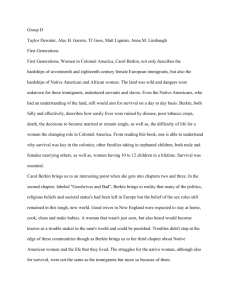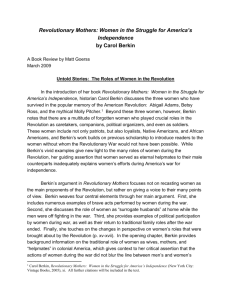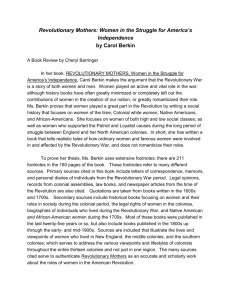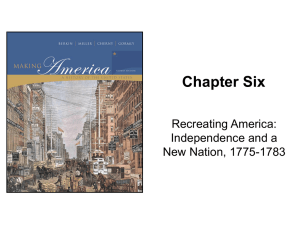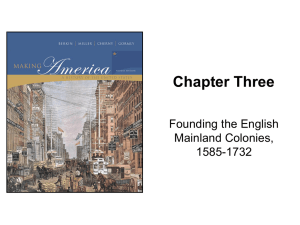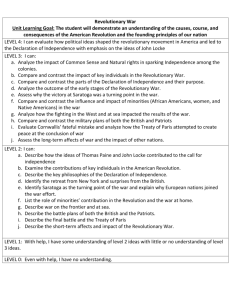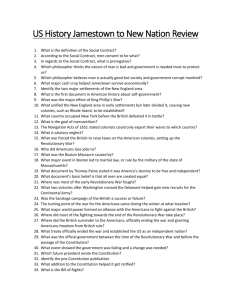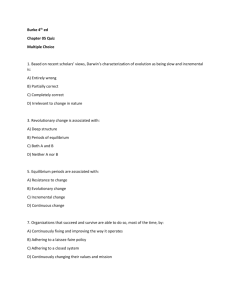Historical Book Review
advertisement
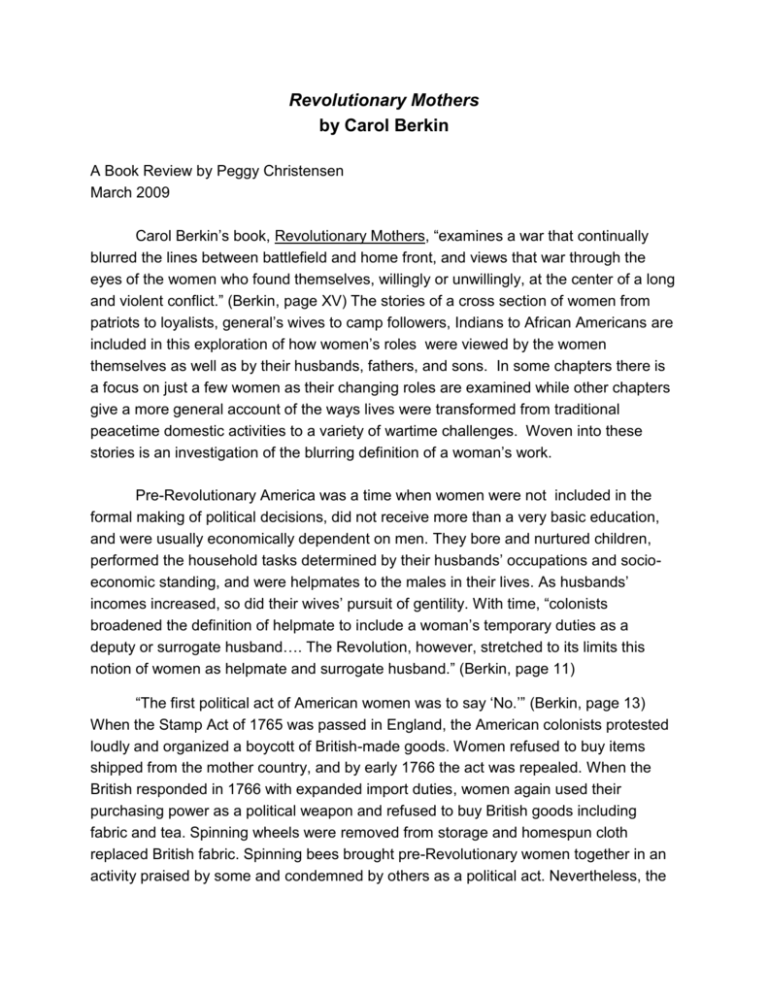
Revolutionary Mothers by Carol Berkin A Book Review by Peggy Christensen March 2009 Carol Berkin’s book, Revolutionary Mothers, “examines a war that continually blurred the lines between battlefield and home front, and views that war through the eyes of the women who found themselves, willingly or unwillingly, at the center of a long and violent conflict.” (Berkin, page XV) The stories of a cross section of women from patriots to loyalists, general’s wives to camp followers, Indians to African Americans are included in this exploration of how women’s roles were viewed by the women themselves as well as by their husbands, fathers, and sons. In some chapters there is a focus on just a few women as their changing roles are examined while other chapters give a more general account of the ways lives were transformed from traditional peacetime domestic activities to a variety of wartime challenges. Woven into these stories is an investigation of the blurring definition of a woman’s work. Pre-Revolutionary America was a time when women were not included in the formal making of political decisions, did not receive more than a very basic education, and were usually economically dependent on men. They bore and nurtured children, performed the household tasks determined by their husbands’ occupations and socioeconomic standing, and were helpmates to the males in their lives. As husbands’ incomes increased, so did their wives’ pursuit of gentility. With time, “colonists broadened the definition of helpmate to include a woman’s temporary duties as a deputy or surrogate husband…. The Revolution, however, stretched to its limits this notion of women as helpmate and surrogate husband.” (Berkin, page 11) “The first political act of American women was to say ‘No.’” (Berkin, page 13) When the Stamp Act of 1765 was passed in England, the American colonists protested loudly and organized a boycott of British-made goods. Women refused to buy items shipped from the mother country, and by early 1766 the act was repealed. When the British responded in 1766 with expanded import duties, women again used their purchasing power as a political weapon and refused to buy British goods including fabric and tea. Spinning wheels were removed from storage and homespun cloth replaced British fabric. Spinning bees brought pre-Revolutionary women together in an activity praised by some and condemned by others as a political act. Nevertheless, the refusal of many women to purchase British goods again forced the repeal of an unpopular regulation. However, tension between the mother country and colonies was still very evident and erupted in the “Boston Massacre” of 1770. Following the Tea Act of 1773 and the dumping of tea into Boston harbor, the Edenton Resolves signaled the willingness of a group of fifty-one women to “compose and sign an agreement to boycott all British-made goods and products.”(Berkin, page 21) In contrast, there were still many colonists who tried not to get involved in the conflict; however, the British government was so angered by the economic fallout of the boycotts and the destruction of tea that the Intolerable Acts were passed in an effort to regain control of Massachusetts. Their efforts backfired, and in 1774 the first Continental Congress demanded that the Intolerable Acts be repealed and that there be another boycott of British goods. Berkin concluded, “Outside the halls of government, the lines drawn between what came to be known as colonial loyalists and colonial patriots had also hardened. Violence erupted as radical men and women tried to pressure their neighbors into supporting colonial resistance.” (Berkin, page 24) Soon Lexington Green was the setting as “the shot heard round the world” was fired and colonial men were recruited or enlisted while their womenfolk faced the challenge of keeping homes, farms, plantations, and businesses afloat. They improvised when faced with shortages and tried to keep going when inflation and scarcity made purchasing many items impossible. “Women’s efforts to save the family resources were made more difficult by the demands of the military. Whether they were victorious armies or armies on the run, they could destroy in a moment what women of all social classes had labored to preserve.” (Berkin, page 34 With this background in place, Carol Berkin shares the stories of several women during this home-front civil war that saw neighbors fighting each other while supporting or challenging the Crown. Some of the women mentioned in Revolutionary Mothers like Abigail Adams and Martha Washington were famous, but others like Eliza Wilkinson were not. After soldiers stripped her home of all valuables, Eliza reportedly said: “The whole world appeared to me as a theatre, where nothing was acted but cruelty, bloodshed, and oppression; where neither age nor sex escaped the horrors of injustice and violence; where lives and property of the innocent and inoffensive were in continual danger, and the lawless power ranged at large.” (Berkin, page 36) Acts of brutality were committed by both sides. Women were attacked while the property they guarded was confiscated, yet some women chose to destroy what they tried to protect rather than have it fall into the hands of their enemies. Others attempted to capture, wound, or kill invaders. Tales of their deeds spread. Berkin is quick to acknowledge that some of these stories might be exaggerated, but many are likely true. Women like Mary Fraier of Pennsylvania tried to contribute to the public defense by collecting clothing for the troops while others donated anything they could find that could be turned into shot. Elizabeth Burgin managed to get food and supplies to captured patriots while Benjamin Franklin’s daughter, Sarah Franklin Bache, joined with others to launch a massive fund raising campaign and then to make shirts for the struggling patriot army. Other women followed the armies. These women served as cooks, washerwomen, nurses, seamstresses, and camp wives. Although they were often considered nuisances by the generals who tried to provide them with food, minimal shelter, and meager pay; their labor was needed if not valued. More women gravitated to the better equipped and supplied British Army then the struggling Continental Army. Many, but not all, the women were trying to escape poverty, starvation, loneliness, and fear of attack. Some followers were tradeswomen trying to sell supplies to the army, others were prostitutes; some were the wives of top ranking officers who tried to lift the spirits of their husbands, others were simply trying to be near their mates. Carol Berkin notes that “George Washington was especially perplexed and annoyed by the women who sought refuge in his camps…. The women refused to obey Washington’s instructions. “(page55) “Yet as even Washington would have had to admit, most of the women were absolutely necessary, if for no other reason than to cut down on desertions.” (page 56) Although the women who followed the armies often presented him with challenges, Washington’s own cook, Sarah Osborn, was admired for her determination to provide food for soldiers during the battle of Yorktown; and his wife, Martha Washington, was appreciated for helping to provide a makeshift social season to distract the officers from the demands of winter encampments. Martha Washington was basically a homebody who felt it was her duty to venture from the relative comfort of her home to join her husband when he requested her presence. Although as the wife of a general she was spared the horrible living conditions of the majority of camp followers, she spent eight winters in Continental Army camps. “Wherever she went, she impressed those who saw her as an amiable, unpretentious woman, who could be found knitting or sewing for her husband and his troops.” (Berkin, page 71) Some women like Anna Maria Lane and Margaret Corbin wore men’s clothing so they could enlist and fight along with their husbands. Their deception was admired while those who masqueraded as men to get the enlistment bounty were usually condemned. One exception was Deborah Sampson who served for several years before her sex was discovered and she was honorably discharged. Sally St. Clair was another successful imposter whose sex was not known by the troops until after she was killed in battle. Whether they were fighting, nursing, cooking, washing, or just comforting, the camp followers were a determined force which caused Berkin to include the following comment. “A British army officer saw through the dirt and grime: ’If (we) had destroyed all the men in North America,’ he said, ‘we should have enough to do to conquer the women.’” (Berkin, page 66) Some officers’ wives “welcomed the war as an opportunity for adventure, friendships with prominent women, and the attention and companionship of young officers….” (Berkin, page 74) Caty Greene is a perfect example. Married to General Nathanael Greene who was twelve years her senior, she begged for and received from her husband permission to visit him each winter. “Martha Washington and Caty Greene had few counterparts in the British army. British generals preferred camp wives to real ones.” (Berkin, page 81) Baroness von Riedesel, wife of a Hessian general working for the British, was an exception. Her husband gave her permission to join him which she eventually managed to do. Their reunion was brief, and she soon found herself nursing the wounded and comforting sufferers. When the British army capitulated, the baroness feared the treatment she and her children would receive as prisoners, but was delighted to discover that the Americans would treat her as a lady and that the opposing generals interacted amiably. Like Martha Washington and Caty Greene, the baroness was respected and praised while the ordinary camp followers were not. Grace Galloway’s social life was drastically changed when her prominent husband announced his loyalty to the king and aided the British when they occupied Philadelphia. “As former friends turned their backs on her, as men of her social circle helped reduce her to poverty, Grace Galloway discovered how tied her fate was not only to her husband’s whims, but to his politics.” (Berkin, page 94) Less affluent women were also targeted by patriot groups not because they declared loyalty to the crown, but because they were related to loyalists. Many of these women chose to leave their homes and try to make their way British territory. However, some loyalist wives remained in their communities where they could aid soldiers, sabotage enemy supplies, and spy on patriots during the Revolutionary War. When the war concluded, many of these loyalists ended up in Canada far away from the communities and friends they once enjoyed. Indian women faced different challenges. Many of them had a public voice and helped their tribes determine whether an alliance with the patriots or loyalists would offer the best chance of continued trade with the colonists and retention of their land. Gender roles in Indian societies were very different from those of the colonists. Indian women farmed while their husbands hunted. In agricultural societies, this gave the women a powerful voice. Mary Brant was born a Mohawk Indian but married Sir William Johnson who was a wealthy New York landowner and the northern superintendent of Indian affairs for the British. Like her husband, she had a strong political voice and both had considerable influence in their societies. “For twenty-two years, Molly and Sir William represented the possibility of peaceful coexistence and mutual respect between the two races. While Britain ruled the colonies, Molly Brant’s two worlds, the white and the Indian, seemed to be in harmony. The American Revolution shattered that harmony and effectively ended the power that Molly’s Iroquois kinsmen and women had wielded for almost two centuries.” (Berkin, page 111) When her husband died, Molly remained a loyalist and tried to help both her own people and the British. The British did not forget Molly’s assistance and rewarded her with land in Canada following their defeat. She lived there in exile until her death. Nancy Ward, known as Nanyehi to her Cherokee tribe; Queen Esther Montour of the Munsee Delaware; and the Seneca tribeswoman, Mary Jemison, all knew life in both white and Indian society. These women “had no counterparts in colonial American society. The authority and autonomy that the women enjoyed in their Indian societies stood in stark contrast to the accepted subordination and economic dependency of colonial farmwives or urban mothers.” (Berkin, page 119) “While leading patriots decried the king’s efforts to enslave his American subjects, African American slavery was an accepted social institution in every American colony.” (Berkin, page 120) The value of African Americans was recognized by both sides. The patriots needed soldiers and workers while the loyalists hoped to cripple the rebels’ economy by enticing their slave labor to join the British cause. While planters fought to prevent the loss of their slaves, many African Americans managed to reach the freedom of British lines where they were set to work on a variety of backbreaking tasks. Some who fled bondage joined the loyalists only to escape their masters. Dinah and Hannah of the Linning plantation went with the British following their surrender of Charleston and ultimately reached Canada. However, “the majority of African American slave women did not flee. Some may have feared for the safety of their children …. Others may have feared reprisals if they were captured or returned to their masters.” (Berkin, page 126) The former slaves who managed to reach Canada were free but lived in poverty, and many of them indentured themselves to whites in an effort to survive. “Many nameless African American women died of starvation and enemy attack…. Many who won their freedom lost it again through violence and trickery…. Many more died in the attempt to gain it. Those who succeeded faced racial prejudice in exile that resulted in poverty and injustice. Those who remained in the South found the reins of slavery tighten around them.” (Berkin, page 134) Like many other women of the American Revolution, the lives of African Americans grew more difficult as the conflict raged. The final group whose lives Carol Berkin examined in Revolutionary Mothers was the heroines who emerged. Deborah Champion’s daring ride to deliver a message to General Washington, Margaret Corbin’s efforts to man her husband’s cannon until she too was struck, Sybil Ludington’s delivery of a call to arms message, the spying Lydia Darragh did to gain valuable information about an impending attack and her ability to warn General Washington are a few of the stories highlighted. Mammy Kate’s prison rescue of her master, Stephen Heard, who had been captured by loyalist forces, underscores the devotion and bravery of African American women while Rebecca Motte represents those women who willingly destroyed their own homes to keep them from sheltering their enemies. As this chapter of Revolutionary Mothers concludes, Carol Berkin states: “The war for independence allowed, and often propelled, these women to step out of their traditional female roles for the briefest of moments and to perform deeds that surprised them perhaps as much as they surprised others. When the war ended, however, these women returned to their kitchens and parlors, to nurseries and gardens-and to the anonymity their society considered feminine…. In their return to ordinary lives and familiar gender roles, these women share a bond with the thousands of American soldiers who became, once again, farmers and farm laborers, planters and merchants, dock workers and shop keepers when the war was over.” (Berkin, pages 146-147) Carol Berkin is both a noted historian and a skillful storyteller. As she shares colorful anecdotes about a cross section of Revolutionary women, she supports her argument that gender roles were blurred during the Revolutionary War and that women were key players in the conflict. Her evidence is both entertaining and historically factual. She does explain that some exaggerated stories of heroines likely exist, but she appears to have limited her narrative to included only carefully documented cases. Berkin does draw upon material from previous texts she has written both by herself and in collaboration with other historians and has noted the work of scholars like Mary Beth Norton, Elaine Crane, Linda Kerber, and Marylynn Salmon as an important starting point in her research for Revolutionary Mothers. This narrative has neither the feel nor the appearance of a weighty text. Authorities are not mentioned within the narrative, but their key points and quotations from their publications are credited in the notes found just before the acknowledgments and index. There is not a formal bibliography, rather the notes at the end are arranged by chapter and provide the documentation necessary to track information and locate primary sources like newspaper headlines and articles published during the revolution, letters written by women like Abigail Adams, and military dispatches and records. Although some primary sources are quoted, the vast majority of sources are secondary. Given the tone of Revolutionary Mothers, this is certainly appropriate. Carol Berkin noted in the introduction that: “It is important to tell the story of the Revolution and its aftermath with the complexity it deserves. But it is also important to tell it as a story of both men and women. “ (Berin, page xi) “The Revolution did lend legitimacy to new ideas about women’s capacities and their proper roles. Although practice did not keep pace with theory, postwar society offered new opportunities for some women, and postwar intellectuals reinterpreted women’s traditional roles in ways that eventually led to change. These shifts in perspective, whose implications were never fully recognized or realized by the Revolutionary War generation, are the final piece of this story.” (Berkin, page xvii) The final chapter of Revolutionary Mothers is subtitled “The Legacy of Revolution.” Here Berkin points out that postwar society no longer considered women intellectually or morally inferior to men. “Women’s participation in the war had given concrete, empirical evidence of their ability to think rationally and make ethical judgments.” (Berkin, pages 151-152) Education with rigorous curricula was recognized as a necessity for women to become informed citizens, to support their husbands, and to nurture their sons. However, women’s legal rights and economic opportunities were still very limited as noted by Abigail Adams who wrote to her husband: “I can not say that I think you very generous to the Ladies, for whilst you are proclaiming peace and good will to Men, Emancipating all Nations, you insist upon retaining an absolute power over Wives.” (Berkin, page 158) While she tried to influence and persuade her husband, Abigail Adams did not petition him for suffrage. Like other women in post Revolutionary America, she saw her role in politics as “behind the scene.” She was comfortable sharing her views with her husband, but she did not request political power. That was a quest for future generations. As I read Revolutionary Mothers, I formed a mental image of Boston with its shops and farms, its bustling seaport and dockside taverns. The lives of a cross section of women were discussed against the backdrop of political meetings at Fanueil Hall, the “Boston Massacre” of 1770, the Boston Tea Party, and the British occupation of Boston. I now feel a deeper connection to these places and events, and I no longer think of just the male participants as British troops and loyalists clashed with patriots in the streets of Boston. Carol Berkin has introduced me to the contributions of many women whose stories I’d never heard. As I assign biographies and compare/contrast papers to my students, I now have an expanded list of names to share and examples to present. I also have a better understanding of how the Revolution War provided a key stimulus for changing the multiple roles women play. Revolutionary Mothers is an entertaining and informative book that I highly recommend. Carol Berkin has blended analysis and anecdotes to illustrate her thesis that women’s roles were blurred during the Revolutionary War and that many women of this era were in fact active participants not just quiet observers during this conflict. She has also left me eager to read the next installment in the advancement of women’s rights and expectations.
